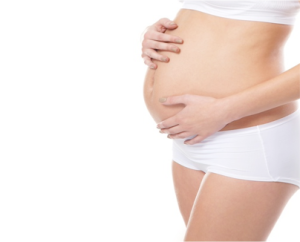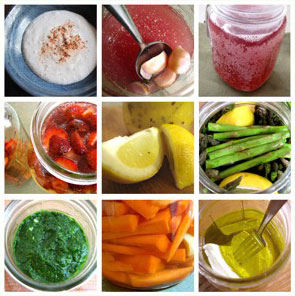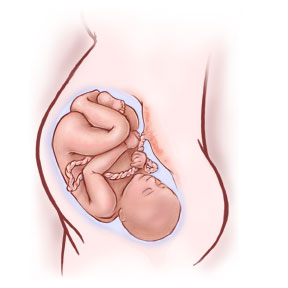The last few weeks of pregnancy are vitally important. Here are some suggestions for a mother during her final stages of pregnancy.
1. Crawl On All Fours (Hands And Knees) For Five To Ten Minutes, Twice A Day
This position allows optimum room for your baby to correctly place itself within your pelvis. This task is particularly benefcial if, upon abdominal examination, you find that your baby has rotated within your pelvis (into a posterior position, for example), or is yet to move down into your pelvis.
Posterior babies used to be uncommon in previous decades. It has been suggested that this is because women of these times would regularly scrub the floor on their hands and knees (I did say previous decades). This type of “all-fours” posture, utilises gravity’s assistance and encourages babies to move anteriorly into the pelvis.
In preparation for birth we need to make a conscious effort to crawl around the house. If you feel inclined, embrace those ‘nesting urges’ and get down on your hands and knees and dust those neglected skirting boards and corners! Alternatively I much preferred to read a magazine or book whilst on all fours.
 2. Keep An Upright Posture
2. Keep An Upright Posture
Avoid sitting in a reclined position (backward leaning) on the couch or in the car, as these postures do not encourage correct positioning for your baby. If your’e watching a movie – sit on the couch but lean forward over a mediball (large exercise ball) or kneel and lay your upper body over a mediball.
If you have to embark on a long drive. Stop regularly and walk around for an extended period. Sit upright in the car or lie on your side.
3. Ensure Your Spine Is Aligned For A More Straightforward Birth
Due to hormonal changes and gravitational forces, pregnant women often develop specific subluxation and postural patterns. Research shows that correct alignment of the pelvis and spine may contribute to more straightforward labours with less pain and trauma for mother and child.
Subluxations in pregnant women may have “severe long-term consequences as the patient will be prone to protracted (long) labour, intense back pain during her labour and disordered uterine action (contractions that are inconsistent)”.1
Chiropractors help ensure that your spine is properly aligned and subluxation-free and regular visits while you are pregnant will diminish the chance of complications during labour. Please see “In Pregnancy, Can Adjustments Impact How Your Child Learns?”
4. Perform Regular Perineal Massage
This is important, particularly if this is your first birth, or if you have suffered perineal tears with a previous birth. This massage, while at times painful and difficult, is one of the best methods for physically preparing the body for birth.
Please see Why Is Perineal Massage Important?
“I do not know of any woman who has routinely performed daily perineal massage from 30 weeks gestation who has needed an episiotomy.”
DR MARITA SMITH, CHIROPRACTOR, REGISTERED MIDWIFE AND NURSE.
5. Perform Pelvic Floor Strengthening Exercises
Keeping your pelvic floor strong at this late stage of pregnancy ensures quicker recovery post-birth.
A common complaint of new mothers is that no one tells them how ‘heavy and sore’ their body can feel after a labour. There are few things worse than feeling as if you have to physically hold your pelvic floor as you climb a set of stairs. So get busy with these strengthening exercises. Please see Why Should I Strengthen My Pelvic Floor later in Well Adjusted Babies.
 6. Apply Vitamin E Or Jojoba Oil To Your Perineal Area Daily
6. Apply Vitamin E Or Jojoba Oil To Your Perineal Area Daily
This activity helps to soften the area. If you are a new mother, your perineum has not had to stretch and accommodate for the passing of a small being before. So help your body by encouraging elasticity. This will also be useful if you have previously experienced perineal tears.
7. Apply Oils And Creams Onto Your Stomach And Breasts To Help Prevent Stretch Marks
It is beneficial to continue applying these lotions pre and post-birth, as your milk comes in and the breast tissue is further stretched.
8. Breast Massage In The Last Few Weeks Of Your Pregnancy Has Been Suggested By Some Authors To Increase Milk Supply
With this massage you may experience some colostrum leakage; this is natural. Knowing that you have abundant colostrum and breast milk available for your newborn instils great confidence in a new mum.
 9. Drink Plenty Of Raspberry Leaf And Stinging Nettle Tea
9. Drink Plenty Of Raspberry Leaf And Stinging Nettle Tea
These teas are available from health food stores. Use two handfuls of dried leaves and cover with boiling water in a litre jar, leave for four hours, strain and drink one cup per day. If making fresh, use three quarters of a teaspoon per cup.
Raspberry Leaf tea can be used alone or in combination with Squaw Vine, Beth Root and Blue Cohosh to help encourage a steady labour.2
Stinging Nettle teas are rich in iron and vitamin K, which help to reduce the risk of haemorrhage and improve recovery post-birth. Nettles also help to reduce haemorrhoids as they are mildly astringent and strengthen blood vessel walls. Stinging Nettles are also beneficial during the first trimester.3
Drink Raspberry Leaf tea regularly in the last six weeks of pregnancy as it is highly nutritious. Containing calcium, iron, folic acid and vitamin E, it pre- pares your body for birthing by helping to soften your cervix. Raspberry leaves consumed after labour also help milk production and hasten recovery of the uterus and pelvic area, post-birth.4
10. Utilise Homeopathics
Speak to a registered homeopath for their recommendations.
 11. Be Particularly Mindful Of Your Diet In These Last Few Weeks
11. Be Particularly Mindful Of Your Diet In These Last Few Weeks
In the last few weeks of pregnancy, focus on attaining enough vitamin C, B, E, K, iron, zinc and probiotics. Vegetarian mothers will also need to attain plenty of calcium and vitamin B12. Nothing beats getting these vitamins and minerals naturally from foods. Please refer to Chapter 5 in Well Adjusted Babies for foods rich in specific vitamins and other dietary recommendations.
Here are some additional tips:
– Vitamin C—attained through good quality fruits and vegetables. Vitamin C is vital for foetal development and for a mother’s increased demands of collagen for her growing breasts and stomach. Furthermore, vitamin C helps with the rate of post-labour healing, boosts your immunity and aids the body’s ability to absorb iron (sustained iron levels are vital).
– Vitamins B (in particular B2, B6, B9 and B12)—they may help to reduce the risk of both pre-eclampsia and intra-uterine growth retardation.
– Vitamin E—firstly from your diet, then in supplement form. Vitamin E is a valuable antioxidant; it protects against haemorrhoids and varicose veins, normalises blood pressure and aids delivery.
– Vitamin K—important for proper blood clotting and the prevention of haemorrhage.
– Zinc—this mineral helps prevent stretch marks, perineal tearing and cracked nipples, and is important for foetal growth. Including zinc-rich foods every day in your diet may also help to prevent birth defects.5
– Iron—a pregnant mother’s diet should be rich in iron throughout her pregnancy, particularly in the last trimester. If this is your first pregnancy you may not need to take an iron supplement; with subsequent pregnancies, your blood tests may indicate lower iron levels and additional iron supplements (non-chelated) are required.
12. Try Breathing Out When Having A Bowel Motion
This helps a pregnant mother learn how to relax and release her pelvic floor. Please refer to the Benefits of Strengthening the Pelvic Floor section later in this chapter.
13. Have A Nap Each Day
Adequate rest is important for both you and your growing baby.
“Take rest; a field that has rested gives a bountiful crop.”
-OVID (43 BC-17 AD)
14. Correct Sleeping Position
It is recommended that once you know that your baby is correctly positioned towards the front of your uterus (best checked by your midwife), that you lie pre-dominantly on the same side as your baby’s back to encourage him/her to stay in this same position.
As you lay on your side, place a small pillow underneath your pendulous belly (i.e. between your belly and the mattress). This helps to prevent the weight of your baby pulling your pelvis forward. Then place another small pillow between your knees to assist correct alignment of your spine and pelvis.
 15. Visualise,Visualise,Visualise
15. Visualise,Visualise,Visualise
Your Baby’s Ideal Position For Birth
Visualise your baby’s position for birth:
- Head down
- With their chin tucked down onto chest
- Baby’s back to mum’s belly button
- Arms tucked down and against their body
16. Prepare Your Nipples For Breast Feeding By Gently Pinching And Rolling Them
These techniques help prevent nipples becoming too sore when first breastfeeding. These methods also familiarise a woman with handling her breasts and can be performed on both sides for two minutes a day in the last four to six weeks.
A mother can prepare her nipples by not wearing a bra and exposing the nipples to the gentle friction of clothes, also by exposing the nipples to sunlight for a few minutes a day. Rubbing the nipples with wheatgerm oil or expressed colostrum (late in pregnancy) is another important preparatory step.
Don’t rub your nipples with a towel or a brush in an attempt to toughen them, as this will merely rub off skin cells and leave your nipples tender. Also avoid washing your nipples with soap as this will cause them to dry out and promote cracking when they are later stretched.
To Prepare Nipples For Breastfeeding:
Pinching:
Using your thumb and forefinger, gently squeeze just behind the nipple. If your nipple does not protrude, gently pull them outward.
Rolling:
Once you have pinched, roll your nipple between your thumb and forefinger, gently stretching it forward out of your breast.
17. Don’t Tell Your Friends And Family Your Exact Due Date
Being vague about when you will reach your 40 weeks gestation can be very helpful, particularly if you do go over your due date. Remember that babies initiate labour when they are ready. Being discreet avoids repeated phone calls from well meaning friends and family, and helps to minimise impatience for all involved.
To know more details please read Well Adjusted Babies or proceed to read points 18 – 25….
. . . . .
Yours in health…
Jennifer Barham-Floreani
Bach. Chiropractic, Bach. App Clinical Science
Registered internationally, no longer practicing as a chiropractor in Australia.
McMullen M. Spinal Stabilsation and Exercises for the Child Bearing Year. JCCP. 1998;3(1).
2
Cooper D. Your Baby, Your Way. Milsons Point: Random House; 1999.
3
– Simpson M1, Parsons M, Greenwood J, Wade K.J Raspberry leaf in pregnancy: its safety and efficacy in labor.Midwifery Womens Health. 2001 Mar-Apr;46(2):51-9.
– Burn J. H. & Withell E. R. (1941). A principle in raspberry leaves which relaxes uterine muscle. The Lancet, July 5, pp. 1-3.
– Thomas. C. L. (ed.). (1985). Taber’s cyclopedic medical dictionary 16th ed. F. A. Davis: Philadelphia.
https://www.botanical.com/botanical/mgmh/r/raspbe05.html
https://www.theholisticchannel.com/Herb/Red_Raspberry.htm
– Parsons, M. (1999). Raspberry leaf. Pregnancy, Birth and Beyond Newsletter, 1(2), pp. 1-2.
– Parsons, M. (2000). [Raspberry leaf]. Emailed report
– Queensland Health. (1997). A health start in life: Nutrition for mother and child. Author: Coorparoo.
– Whitehouse B. (1941). Fragrance: an inhibitor of uterine action. British Medical Journal, Sept 13, pp. 370-371.
4
Stinging Nettle Effects, Health Benefits, Side Effects. Medical Health Guide.
https://www.ncbi.nlm.nih.gov/pubmed/11370690
https://www.medicalhealthguide.com/herb/nettle.htm
5
– Laura M. Plum, Lothar Rink, and Hajo Haase*The Essential Toxin: Impact of Zinc on Human Health. Int J Environ Res Public Health. Apr 2010; 7(4): 1342–1365.
Published online Mar 26, 2010. doi: 10.3390/ijerph7041342
PMCID: PMC2872358
– Michael Hambidge. Human Zinc Deficiency. Journal of Nutrition Journal of Nutrition https://jn.nutrition.org/content/130/5/1344S.full








